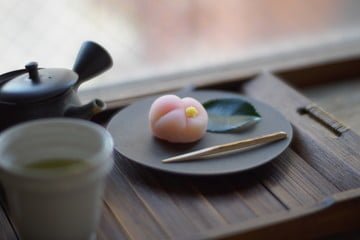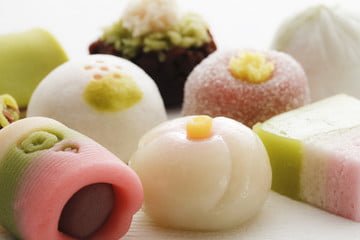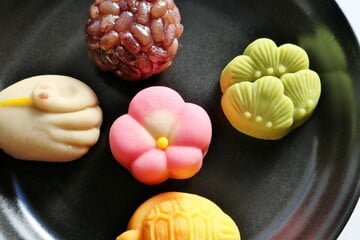Wagashi, the traditional confections of Japan
Wagashi, the traditional confections of Japan, are more than just sweets; they are edible art forms that embody centuries of cultural heritage. With a history stretching back to the Jomon period (14,000-300 BCE), wagashi have evolved alongside Japanese society, reflecting changes in tastes, techniques, and cultural influences.
The origins of wagashi can be traced to simple sweets made from nuts and fruits. As Japan’s cultural exchange with China grew during the Tang Dynasty (618-907 CE), new ingredients and preparation methods were introduced, enriching the variety of Japanese confections. The tea ceremony’s development in the 15th and 16th centuries further elevated wagashi’s cultural significance, as these sweets became an integral part of the ritual.

Today, wagashi come in a myriad of forms, each showcasing the artisan’s skill and attention to detail. Some common types include:
- Namagashi: Soft, fresh confections often shaped to represent seasonal motifs.
- Higashi: Dry confections made from sugar and rice flour, pressed into intricate shapes.
- Mochi: Soft, pounded rice cakes, often filled with sweet bean paste.
- Yokan: A thick, jellied dessert made from red bean paste, agar, and sugar.
What sets wagashi apart is not just their taste, but their deep connection to Japanese aesthetics and philosophy. Each piece is carefully crafted to appeal to all senses, reflecting the changing seasons and natural beauty of Japan. The concept of ‘mono no aware,’ or the pathos of things, is often embodied in wagashi, reminding us of the transient nature of beauty.

Wagashi’s ingredients
The ingredients used in wagashi are primarily plant-based, with an emphasis on natural, seasonal flavors. Common components include:
- Mochi (pounded rice)
- Anko (sweet red bean paste)
- Kanten (agar derived from seaweed)
- Various nuts, fruits, and flower essences
As Japan continues to navigate the balance between tradition and modernity, wagashi remain a steadfast emblem of the nation’s cultural heritage. They serve not only as a sweet treat but as a meditative experience, a moment of reflection amidst the chaos of contemporary life.

For those outside of Japan, encountering wagashi for the first time can be a revelation. These aren’t just desserts; they’re an introduction to a different way of perceiving food, art, and the passage of time. In every bite of wagashi, one tastes not just sugar and bean paste, but centuries of tradition, a reverence for nature, and the bittersweet beauty of impermanence.
As we celebrate these exquisite confections, we also honor the skilled artisans who continue to preserve and innovate this sweet aspect of Japanese culture. Wagashi remind us that even in our fast-paced world, there is still room for moments of quiet appreciation and the joy of savoring life’s fleeting pleasures.
